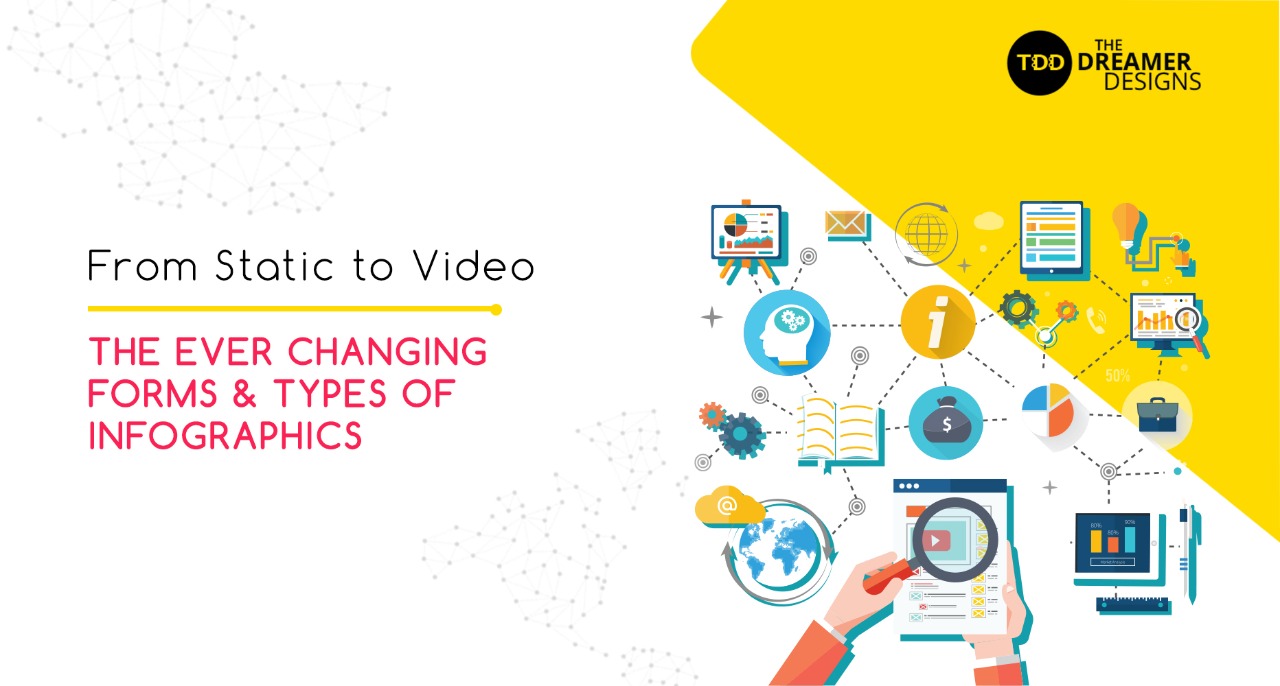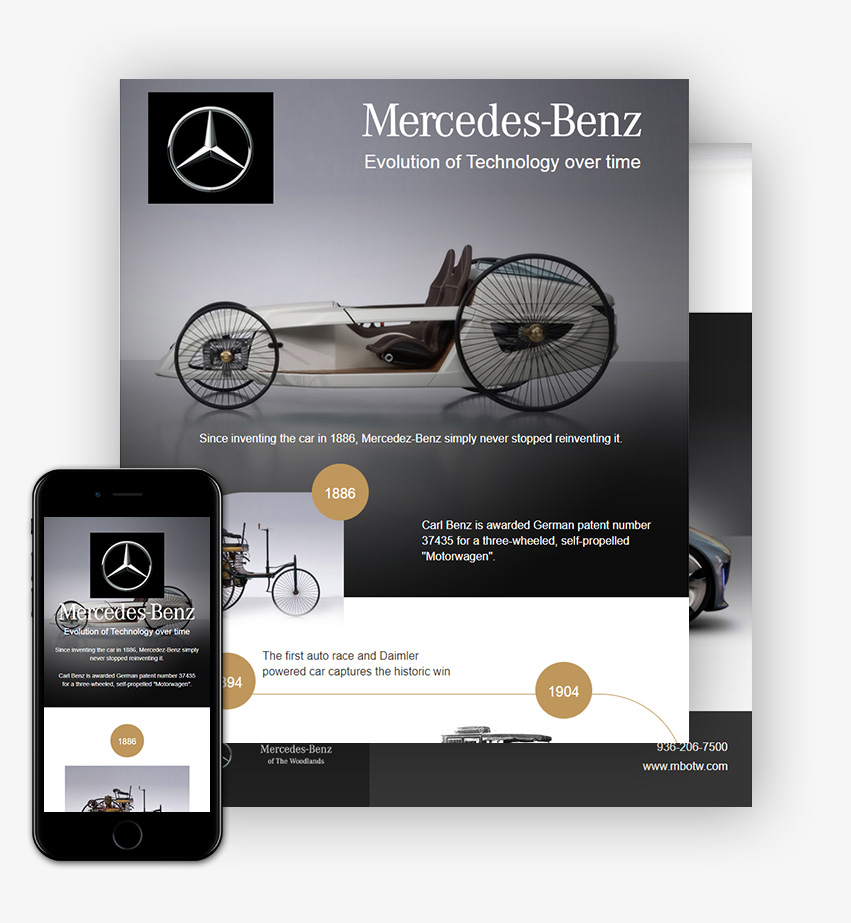
Have you come across an infographic and want something similar designed for your company? Well, you’re in the right place. In this article, we will talk about the different types of infographics and their ever changing forms – from Static to GIFs to Videos.Since there are so many types of infographics, covering them in this article won’t be possible. Instead we’ll talk about the most popular infographic design formats in 2019 and how you can use them to shoot up your company’s online presence.
Popular Types of Infographics in 2019
Read on to find out which type of infographic can best suit your business.
Static Infographics
Static infographics are the original informative infographics! These infographics subtly combine text and images to present a compelling story that attracts the attention of the audience. Generally used to represent difficult concepts and data into comprehensible chunks, static infographics work as great information providing tools. Most static infographics use graphs, maps, charts, and other such visual elements to present any given data. This data is then easy-to-grasp and retain owing to the findings that visual impact leads to more retention.
Although all types of infographics share similarities with static infographics, the thing that sets them apart is that they are not interactive. A static infographic will only present your data is a linear manner, without needing any input or interaction from the user. This is a huge drawback for when user interaction is key. However, if you want to present information, static infographics can work quite well.
Static infographics are quite popular as they help in representing data, visually. Information is conveyed from one end to the other in a creative format. With the easy availability of static infographic templates,

users have been creating a lot of infographics. Problem is, these templates have been used so often and by so many people that they have become very common and fail to produce any reaction. If you want to create a static infographic, you should consider going forward with an infographics designer or an infographics design company to ensure the content you produce is always unique.
Animated Infographics, Popularly Known as Gifographics

Who doesn’t like GIFs? We see them, smile at them and share them. The perfect mix for anything to go viral – use that in your infographic and you’re good to go! Happiness aside, animated infographics are gradually becoming the best infographics owing to the unlimited creative scope they offer. We humans are hardwired to retain visual information, something that static infographics can achieve. However, if you add a little motion to the entire scenario, you get an infographic that is far more visually appealing than its static counterpart. This ensures that chances of retention go higher.
Animated infographics are types of infographics that use animation to bring life to your static infographics. If you’re just starting out, you should pick the best static infographics that you have and recycle them with animation. You would, however, need a good infographics designer for this task. Recycling old infographics with animation makes your best content even more appealing and shareable.
Animation also grabs user attention more quickly than static infographics. Anything that moves on the screen is bound to get a second’s worth of attention, and if your infographic stands out in that instant, it has the potential of going viral. A drawback that comes with animated infographics is that they can only be small, owing to the limitations of GIF creations. However, you can overcome this drawback by breaking down your one big infographic into smaller chunks, which to be honest are a lot better for social sharing!
Interactive Infographics
As the name suggests, interactive infographics are well, interactive. They allow users to manipulate and interact with infographics by asking users to select answers or icons to present information. The great thing about interactive infographics is that they truly engage with your audience, and not just capture their attention. With interactive infographics, you can have multiple storylines leading to different end results. This type of infographic allows the audience to dig deeper without losing out on the bigger picture.
The drawback with interactive infographics is that you would require a programmer to create a good interactive infographic. A lot of infographic design companies, including The Dreamer Designs, create interactive infographics as per user requirements. They can easily help you create infographics that users interact with and get answers based on their selections. However, if your main goal is to provide linear information, sticking to static or animated infographics is the better option.
Interactive infographics are more likely to be shared on social media. If your audience interacts with your infographic, you have achieved in one go, attention and retention. The higher the interaction, the more chances of users retaining humongous information and then sharing it. This helps the basic-goal of an infographic which is to provide information. Another important point to note here is that interactive infographics allow you to capture data. As users interact with your infographic, they provide you with a lot of insights related to the information on the infographic, you on the other hand, get valuable user data which you can use to further your business.
Video Infographics
Videos in their own form, work as great tools for retaining information. According to a study, if you gain information from a video, chances of retaining are higher even after 24 hours. That in itself makes videos a great marketing tool. Video infographics work on the same model. If you create a video infographic, you will be providing a massive chunk of information to your users within a minute. This will allow users to retain more on the subject than with say a traditional static infographic.
Videos are great in bringing forth an emotional connect if presented correctly. Building on the same approach, video infographics allow users to easily connect with the
information on the screen. If the video infographic is about a great cause, users will easily click on the share button. This tells us that video infographics are great tools for conveying information to large audiences.
The drawback of the type of infographic that is in video format is that you will require a designer familiar with creating video infographics. Another drawback of video infographics is that they can be quite heavy, so uploading may also be quite a task. However, videos are becoming very popular on social media platforms, so going the video way is not a bad idea after all.
HTML based Infographics Or Web-based Infographics
There’s always Google to think about! If you want Google to crawl your infographic, it can’t be created in the traditional JPEG format. If it is, Google will mark your infographic as an image and be done with it. However, infographics definition is that they provide information, so shouldn’t this information be crawled and help with your SEO efforts? Well, it should! But for that, you will have to let go of JPEG infographics and move on to the latest HTML based infographics.
HTML based or web-based infographics are becoming increasingly popular owing to their capacity of taking on challenges like responsiveness and SEO. Infographics created via code, keep intact the information provided on the infographic as text. This text is then easily crawled and indexed by search engines like Google, Bing, Yahoo and more.

If you use a lot of keywords in your infographic, you will be able to use it to enhance your SEO efforts. All the information that you have worked hard on creating is easily searchable on Google, allowing a lot of users to land on your website.
The only drawback with HTML based infographics is that they can’t be shared on social media. However, to counteract that, you can create a JPEG of your HTML infographic and add a link which leads directly to your website. HTML based infographics come with a lot less limitation than its static and animated counterparts. They can be all the types of infographics combined into one.
Another great thing about HTML or web-based infographics is that they are mobile responsive. So even if you create a huge/long infographic, it will appear on your smartphone, exactly like it does on desktop. No zooming required whatsoever! HTML based infographics are types of infographics that are becoming the leaders in the infographics world as they combine animation and interaction to provide information. What’s more, an animated infographic created via HTML doesn’t have any size restrictions!
Conclusions
Now that you’re aware of the types of infographics there are, it’s time to select the best infographic type for your business. If you want to provide linear information, go with a unique but static infographic. If however, you want your static information to capture more attention, your best bet is an animated infographic. Wondering about how to provide massive chunks of information? Go the video infographic way. If you need users to answer questions or to interact with your audience and want to capture data, go with interactive infographics. Coming down to the last one, if you want all the best features of all the infographics, stick to or start with HTML based infographics. These infographics pick the best qualities of all types of infographics and present them in an interactive format, they are searchable by Google and are mobile responsive.
So don’t wait! Pick the infographic that works best with your business at the moment and go with it. You can create infographics using tools available online, however, those can be quite common. To get a unique infographic that is video, interactive or HTML based, you can easily get in touch with us, The Dreamer Designs. With a great team of designers, researchers, and content creators, we have been leading the space of infographics and have designed over 1200 infographics for brands like Mercedes, Nokia, Microsoft, CupoNation and more. We can help you create compelling infographics and are always up for a chat!
